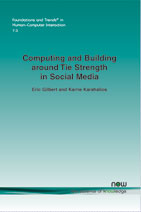Computing and Building Around Tie Strength in Social Media
By Eric Gilbert, Georgia Institute of Technology, USA, gilbert@cc.gatech.edu | Karrie Karahalios, University of Illinois at Urbana-Champaign, USA, kkarahal@illinois.edu
Abstract
Relationships make social media social. But, not all relationships are created equal. We have colleagues with whom we correspond intensely, but not deeply; we have childhood friends we consider close, even if we fell out of touch. Social media, however, treats everybody the same: someone is either a completely trusted friend or a total stranger, with little or nothing in between. In reality, relationships fall everywhere along this spectrum, a topic social science has investigated for decades under the name tie strength, a term for the strength of a relationship between two people. Despite many compelling findings along this line of research, social media does not incorporate tie strength or its lessons. Neither does most research on large-scale social phenomena.
Simply put, we do not understand a basic property of relationships expressed online. This monograph takes a wide view of the problem, merging the theories behind tie strength with the data from social media. We show how to reconstruct tie strength from digital traces in online social media, and how to apply it as a tool in design and analysis. Specifically, this article makes two core contributions. First, it offers a rich, high-accuracy and general way to reconstruct tie strength from digital traces, traces like recency and a message's emotional content. For example, the model can split users into strong and weak ties with nearly 89% accuracy. We argue that it also offers us a chance to rethink many of social media's most fundamental design elements. Next, we showcase an example of how we can redesign social media using tie strength: a Twitter application open to anyone on the internet which puts tie strength at the heart of its design. Through this application, called We Meddle, we show that the tie strength model generalizes to a new online community, and that it can solve real people's practical problems with social media. It may be fair to see this monograph as linking the online to the offline; that is, it connects the traces we leave in social media to how we feel about relationships in real life. We conclude the article by reflecting on other ways design might appropriate ideas like tie strength in social computing.
Computing and Building Around Tie Strength in Social Media
Relationships make social media social. But not all relationships are created equal. We have colleagues with whom we correspond intensely, but not deeply; we have childhood friends we consider close, even if we fell out of touch. Social media, however, treats everybody the same: someone is either a completely trusted friend or a total stranger, with little or nothing in between. In reality, relationships fall everywhere along this spectrum, a topic social science has investigated for decades under the name tie strength, a term for the strength of a relationship between two people. Despite many compelling findings along this line of research, social media does not incorporate tie strength or its lessons. Neither does most research on large-scale social phenomena.
Simply put, we do not understand a basic property of relationships expressed online. Computing and Building around Tie Strength in Social Media takes a wide view of the problem, merging the theories behind tie strength with the data from social media. It shows how to reconstruct tie strength from digital traces in online social media, and how to apply it as a tool in design and analysis. Specifically, this monograph makes two core contributions. First, it offers a rich, high-accuracy and general way to reconstruct tie strength from digital traces; traces like recency and the emotional content of messages. For example, the model can split users into strong and weak ties with nearly 89% accuracy. It outs forward the argument that this offers us a chance to rethink many of social media's most fundamental design elements. Second, it showcases an example of how we can redesign social media using tie strength: a Twitter application open to anyone on the internet which puts tie strength at the heart of its design. Through this application, called We Meddle, it is shown that the tie strength model generalizes to a new online community, and that it can solve real people's practical problems with social media.
In a sense, Computing and Building around Tie Strength in Social Media links the online to the offline as it connects the traces we leave in social media to how we feel about relationships in real life.
